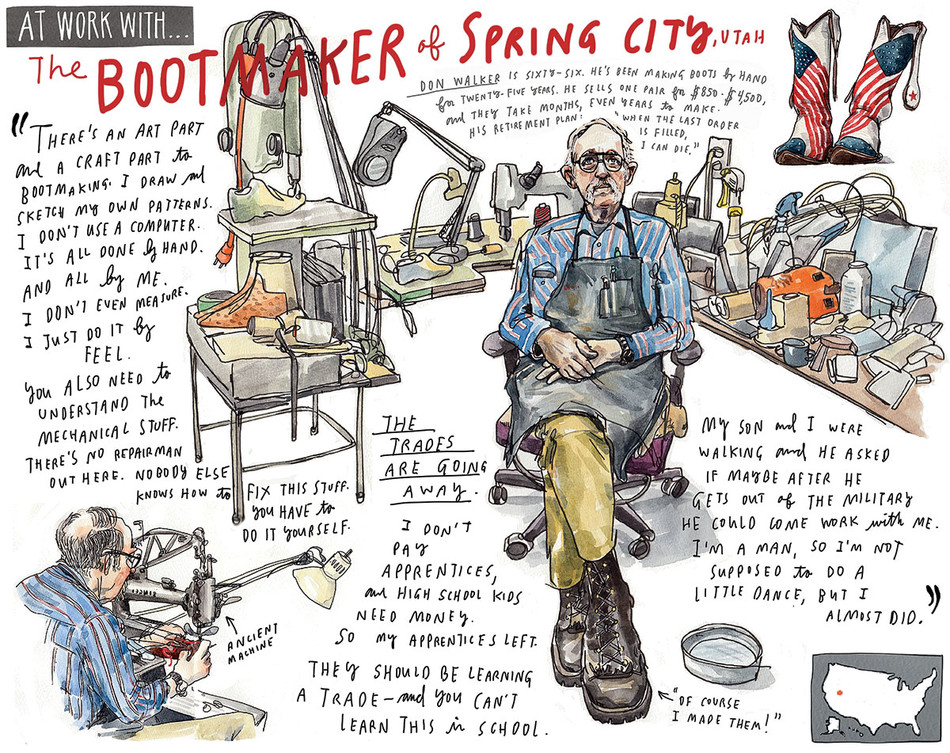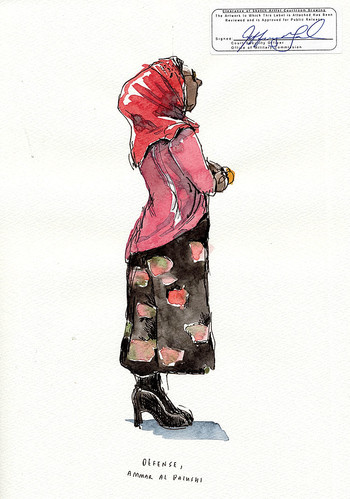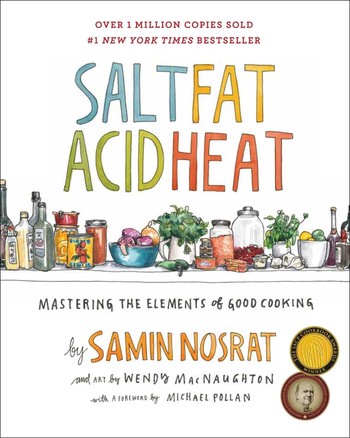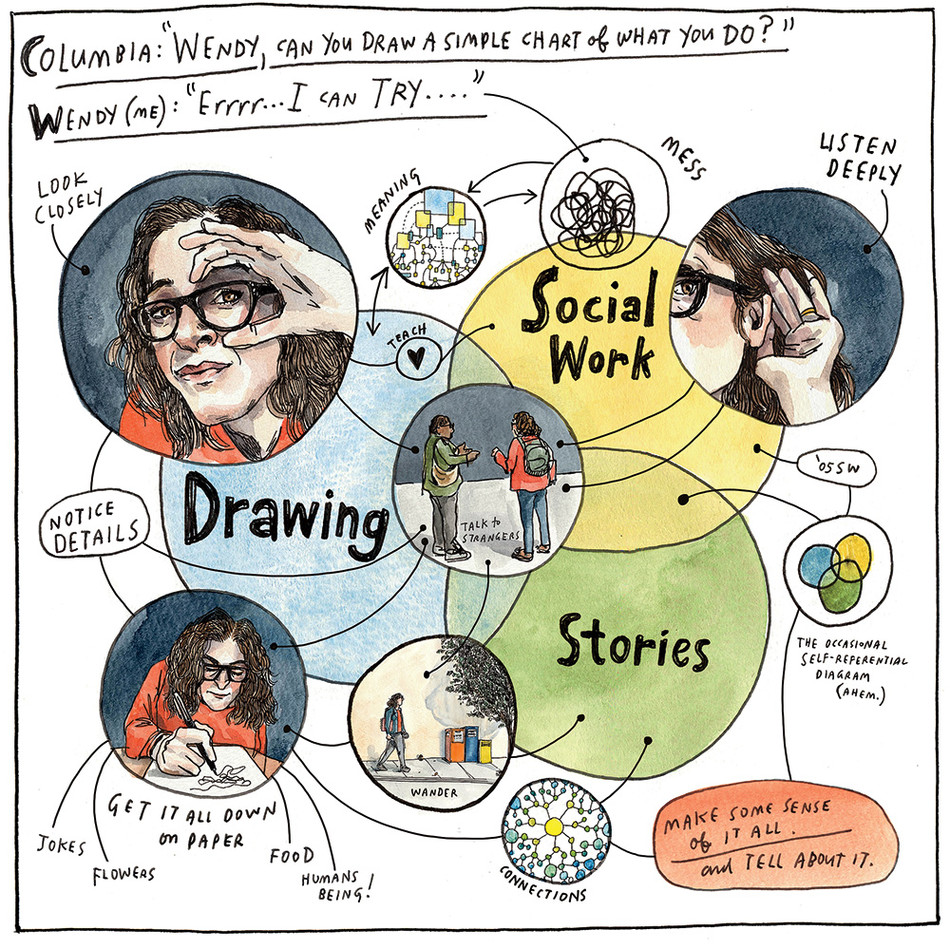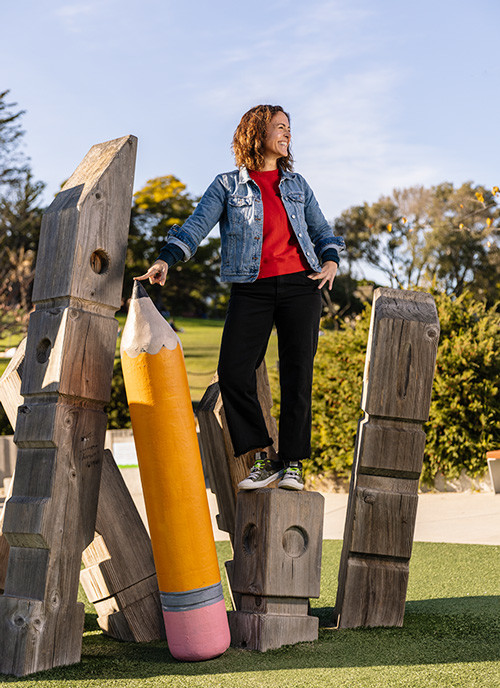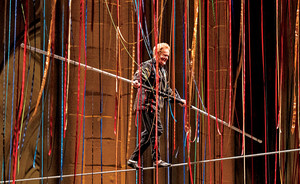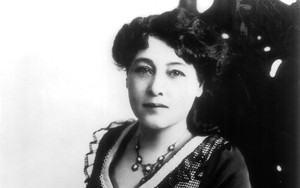Drawing Connections with Wendy MacNaughton
There’s an exercise that has become something of a calling card for Wendy MacNaughton ’05SW — she does it when she’s teaching a class or giving a TED talk or even sometimes when she’s doing an interview. She asks people to choose someone nearby and draw their face. But there are two caveats: They must draw in one continuous line, without lifting the pen off the page. And even more importantly, they can’t look down.
“People have an idea in their head of what a face is supposed to look like, and they’re worried that their drawing isn’t going to look like that,” MacNaughton says. “It’s not. It’s going to be terrible, I promise. But this isn’t about making a pretty picture. It’s about looking at someone, with no distractions and no expectations.”
Looking is important to MacNaughton, who trained as a visual artist, a storyteller, and a social worker and has built a dynamic career at the intersection of those fields. She’s an illustrator and journalist who has published twelve books and was the first visual columnist at the New York Times. She is the cofounder of Women Who Draw, an online directory of underrepresented illustrators that has become a model of inclusion for many industries. And she is the creator and host of DrawTogether, an enormously popular online children’s drawing class turned educational nonprofit that, MacNaughton will quickly say, “isn’t really about drawing at all.”
MacNaughton always draws from life, a choice that she says is vital to the kinds of interactions she strives for and that she believes we can all benefit from. And while her work is beautiful — vibrant and colorful, informative and imaginative, and almost always imbued with whimsy and charm — she says that the end result is secondary to the person-to-person process by which she creates it.
“When I gave my TED talk, I started out talking to a room full of strangers,” she says. “After that drawing exercise, people were coming up to me and telling me that they felt like they made a friend.”
MacNaughton, a fifth-generation San Franciscan, grew up in the North Bay and spent most of her childhood with a pen or pencil in hand. From an early age, she’d set up studios around her house, with butcher paper and a mini-easel that she’d put on a table. As a teenager, she became the first student at her sports-focused high school to get an “art exemption,” allowing her to skip gym and paint instead.
She followed that path to college, earning a BFA from ArtCenter College of Design in Pasadena. But after graduating, MacNaughton stopped drawing for several years, instead taking a job as a copywriter at a large advertising agency.
“When you go to school for fine art, the natural goal is to show your work in a gallery,” she says. “I wasn’t very interested in making art that only thirty people saw, when I could make something that ended up on a billboard that thirty thousand people saw.”
Even though she wasn’t working on the visual side, MacNaughton says, her job as a copywriter was important training for the work she does now. “It’s really about storytelling,” she says. “I learned how to get a message across succinctly and forcefully.”
But MacNaughton quickly realized that commercial advertising wasn’t the right fit for her (“Oddly, luxury fashion labels didn’t seem too taken with my proposed slogan: ‘Do you really need this?’”). So when a contact in the industry put her up for a temporary job in Rwanda, designing the marketing campaign for the country’s first free democratic election, MacNaughton jumped at the opportunity and took a leave of absence.
“Advertising can be very powerful,” she says. “In Rwanda, I realized that I could use those tools to enact real change in the world.”
When MacNaughton returned from Rwanda, she quit her job and pursued a degree in social work at Columbia. In graduate school, she says, she had to fundamentally shift how she thought about the world. “In advertising, I was taught to come up with ways to tell people what they need,” she says. “In social work, you find out what people need and then help them get it. I had to learn how to ask questions instead of coming up with answers.” MacNaughton believes that this kind of thinking — and the work it inspires — is undervalued. “I actually think everyone on earth should be required to get a mini-social-work degree,” she says.
While many of MacNaughton’s classmates became therapists, she was interested in larger-scale community issues. “At Columbia, I learned that if we want to make a change, we really have to understand all the systemic factors contributing to the problem,” she says. MacNaughton hoped to find a way to use her skills as a storyteller to bring about that understanding. She returned to the Bay Area and got a job with a nonprofit that provided marketing for organizations dedicated to social good. “Even though I was doing meaningful work,” MacNaughton says, “I wasn’t really happy, and I didn’t know why.”
MacNaughton was then living in the East Bay and commuting every day by rapid transit to her office in San Francisco. With time to kill, she started bringing her sketchbook on the train and drawing her fellow passengers. “This was before smartphones, so everyone wasn’t looking down,” she says. “They weren’t at home, and they weren’t at work. It was this strange limbo that I was capturing.”
She found that drawing — and specifically this kind of drawing, where she was encountering people she otherwise might not — was filling the void in her professional life. She started visiting corners of San Francisco that once seemed mundane — the public library, for example, or a chess game in a city park — and found that they all held stories if she took the time to look closely enough.
In 2010, those stories became an illustrated documentary series called “Meanwhile” in the online literary magazine The Rumpus and, four years later, a book, Meanwhile in San Francisco. “If Studs Terkel, the great oral historian, had taken up drawing, his work might have looked something like what Wendy MacNaughton has created,” wrote the San Francisco Chronicle about the book. “Like Terkel, MacNaughton gives voice to ordinary people from all walks of life, dignifying them in the process.”
MacNaughton began to move out of her comfort zone, literally and figuratively. She outfitted the back of her Honda SUV with a drawing table, cabinets for art supplies, and a place to sleep. “I wanted to be out in the world, finding stories, without worrying about getting back to my studio to finish them,” she says. “So I built a mobile studio.”
With freedom to roam, MacNaughton also found new homes for her work. In 2016, she took her visual storytelling series to the California Sunday Magazine, where it appeared on the back page of every issue. Two years later, it became a regular feature in the Sunday New York Times — the first visual column in the paper’s history. At first glance, the topics of MacNaughton’s columns don’t have much in common: some are bleak (hospice care in prisons), some whimsical (the surprising history of the plastic “grass” found in takeout sushi containers), and some more random (a profile of an Oakland activist beekeeper or a Utah bootmaker). But they’re all united by one principle: that the small, often overlooked parts of life can be windows to much more.
“I always have a running list of things that I’m interested in,” MacNaughton says. “And I pay attention to whatever tugs at my curiosity.” She found the bootmaker, for example, when she drove past his shop in Utah and got the urge to stop the car and turn around. “He wasn’t expecting me — a sketchbook-carrying, jumpsuit-wearing, urban lefty lesbian,” she says in her TED talk. “But every tool in that shop had a story. I ended up spending hours there. And by the end of the day, we looked different to each other than we had when I walked in.”
In 2019, MacNaughton took on a different kind of an assignment for the Times, spending a week at the military court at Guantánamo Bay, where she sketched defendants on trial for their involvement with the attacks on September 11. MacNaughton, the first civilian artist allowed at the court in nearly three years, was there to illustrate an article by reporter Carol Rosenberg about the clothing of different people in the courtroom. MacNaughton later wrote an essay for the Times about the logistical challenges of drawing in such a restrictive environment, as well as the psychological and emotional toll the experience took on her. “Ms. Rosenberg had warned me that the gulf between the world back home and what I would find at Guantánamo was huge. She also told me a person can understand it only after being there,” MacNaughton wrote. “She was right on both counts.”
Since publishing Meanwhile in San Francisco, MacNaughton has collaborated on eleven more books, including three with her wife, the writer Caroline Paul — Lost Cat, a charming investigation into what might have happened to the couple’s pet on a weeks-long sojourn he took from their house; The Gutsy Girl, a collection of real-life stories meant to inspire girls to take risks and have adventures; and A Little Tea Book, a guide to the popular drink. She’s illustrated books on tattoos, on wine, and even on what famous writers would look like with a punk makeover.
Next summer, Bloomsbury will publish How to Say Goodbye, which MacNaughton wrote and illustrated after spending a year as the artist-in-residence at a six-bed hospice house in San Francisco. “I spoke with people experiencing their last stage of life — their memories, fears, their joys and regrets,” MacNaughton writes, “I sat with family members coming to terms with the loss of their loved ones. And I interviewed caregivers who, for very very little money, performed some of the most loving and heroic and deeply human acts that one person can do for another.”
But MacNaughton’s best-known publication is Salt, Fat, Acid, Heat, the 2017 cookbook she illustrated, written by chef and fellow Bay Area notable Samin Nosrat. MacNaughton says that Nosrat — an alum of Berkeley’s celebrated restaurant Chez Panisse — knew from the start that she wanted to use illustration rather than photography, an unusual choice for a cookbook. “Photography gives a very false representation of what a dish should be,” MacNaughton says. “It makes the reader think that there’s only one way that something can look.”
More than just a collection of recipes, Salt, Fat, Acid, Heat is a deep dive into culinary science, and the illustrations are a crucial part of Nosrat’s ability to teach on the page. In addition to illustrating the recipes, MacNaughton peppers the pages with charts and diagrams, delineating different acids from around the world and what they pair best with and showing readers how to break down a chicken, to name just two examples.
“A lot of the diagrams were actually influenced by models that I studied at Columbia — things like ‘ecosystem mapping,’ which is a tool that social workers use to visualize all of the interconnecting people, organizations, and other factors impacting a problem,” MacNaughton says. “Everything always comes back to social work!”
The book was a hit, reaching the top spot on the New York Times bestseller list and winning nearly every culinary accolade of 2018. A year after it was published, Netflix aired a four-part documentary series based on the book, starring Nosrat. And MacNaughton’s work gained a much bigger following — Clarkson Potter even sold box sets of the book’s illustrations as prints for readers to hang in their kitchens.
But even as MacNaughton’s career was taking off, she and her friend Julia Rothman, another successful illustrator, noticed that many of their fellow women and nonbinary illustrators weren’t getting the same opportunities. Out of the forty-seven New Yorker covers published every year, for example, they realized that only two or three were drawn by women.
“I don’t think editors and art directors were making these decisions on purpose,” MacNaughton says. “People just hire who they know. And at the time, it was mostly white, straight men who were in the position to hire. We decided to do something about that.”
In early 2017, MacNaughton and Rothman launched Women Who Draw, a searchable, visual online database where women and nonbinary illustrators can register their work and share their contact information. While anyone who identifies as female or nonbinary can join, the site particularly strives to highlight the work of people of color, LGBTQ+ people, and other marginalized groups of illustrators.
MacNaughton says that she was unprepared for how enormously successful the database would be. What’s more, she says, it became a model on which other industries based their own similar directories.
“We were happy to develop something that has really proven to work across the board,” she says. “And within our own community, it’s been a way for people to come together, to rally for causes important to us, and to support each other.”
In March 2020, MacNaughton found herself, like the rest of the world, stuck at home, unable to work, and anxious about nearly everything happening outside her now locked doors. While MacNaughton and Paul do not have children, many of their loved ones do, and MacNaughton couldn’t stop thinking about the impact that the pandemic would have on kids (and their parents). She wondered if there was any way she — a self-described “artist, social worker, and professional goofball” — could help, and her mother suggested that she teach some drawing lessons.
So the night before San Francisco closed its public schools, MacNaughton posted on Instagram: “If I popped up at 10 am tomorrow would people want to draw with me?” She decided to draw a dog — inspired by one of her lockdown companions, a mutt named Suso — and set herself up in the living room, with Paul filming live on an iPhone. She hoped that maybe a hundred kids would join. Over twelve thousand showed up.
MacNaughton had intended for DrawTogether to be an occasional thing — five minutes here and there, when she had the time. But it quickly became clear during that tumultuous spring how desperately kids needed something that was, as she says, “part Mister Rogers, part Bob Ross, part jumpy-castle party.” An occasional five minutes turned into thirty minutes a day, five days a week. Over the next few months, MacNaughton and Paul filmed seventy-two live Instagram sessions, with kids logging in from at least seventy different countries all over the world.
Kids connected instantly with “Wendy Mac,” who started each episode with a pencil propped between her nose and her upper lip, an ebullient “Hellooooooo,” and an achingly earnest “I’m so happy to see you,” followed by a warm-up dance party with a reluctant Suso. She’d spend plenty of time painting and chatting, walking kids through the basics of shapes and primary colors as well as all-important subjects like unicorn farts. And at the end of every episode, she’d cut to pictures of kids holding up their masterpieces.
While MacNaughton strongly believes that drawing can help kids in many ways, from building fine motor skills to bolstering decision-making, she is a shout-it-from-the-rooftops evangelist for arts education’s social-emotional benefits, and DrawTogether was the perfect venue to let her inner social worker loose. Tucked into the art lessons were reminders that there’s no such thing as perfection, that mistakes can be beautiful, and that the best thing we can do is to pay attention to one another. She taught kids how to draw “inside weather charts” to gauge their mood, encouraged them to use their imagination when they felt lonely, and noted that sometimes we all need to take a breath and “look at the world one piece at a time.”
In the fall of 2020, it became clear that DrawTogether had the potential to be much more. Largely using their own savings, MacNaughton and Paul built a studio in a nearby theater, complete with cheerful homemade props, like eight-foot cardboard scissors and a giant papier-mâché pencil.
Together, the pair shot twelve new episodes, which they made available for free on YouTube and Substack. While some of their new studio’s more polished features broadened the scope of their project — a magic portal to “Out There,” for example, allowed MacNaughton to patch in guests to explain things like COVID vaccines — MacNaughton and Paul realized that they’d gotten some things right on their earlier episodes. When they tried to use a static camera instead of an iPhone, for example, they realized that they couldn’t get the close-up shots that gave the show its intimate feel. And when professional producers advised them to cut down the episode time, suggesting that kids could always pause the show to finish their drawings, there was a full rebellion.
“People felt rushed,” MacNaughton says. “DrawTogether is supposed to be the opposite of rushing. It was like I’d broken a promise.”
As the pandemic progressed and kids returned to school, MacNaughton started hearing from teachers who were using DrawTogether in their classrooms. MacNaughton — already a passionate advocate for arts education — knew that she could do more to help the cause. She formed a nonprofit organization and, with the help of educational experts, developed lesson plans and a curriculum around the themes that she covered in the show. The pilot program of DrawTogether Classrooms, which provided those resources to one hundred high-needs schools and community organizations, launched in 2021. MacNaughton hopes to expand to ten thousand schools worldwide by next year. At the same time, she and the DrawTogether team have pivoted to producing podcasts rather than new television episodes — which they’ve found work especially well in classrooms — and are wrapping up their second audio season.
“The impact that I saw DrawTogether have on kids made it pretty impossible to ignore that there’s a need for this kind of thing,” MacNaughton says.
While DrawTogether grew out of the unique needs that children had during the pandemic, MacNaughton realized that there was much about the program that adults could benefit from as well. In August 2022, she started DrawTogether Grown-Ups Table, a newsletter for “DrawTogether-minded growns.” Paid subscribers get a new topic and a corresponding exercise each week — in one, for example, she showed readers how Diego Rivera used graph paper to map out his murals, and in another she demonstrated how she would put together a visual column for the New York Times. One week, she simply asked readers to draw what delights them.
With so many projects brewing, MacNaughton says that she’s not illustrating in the traditional sense right now. But, she says, that means her career is exactly where she wants it to be: “My whole heart is in connecting with people — and connecting people to each other — through drawing.”
